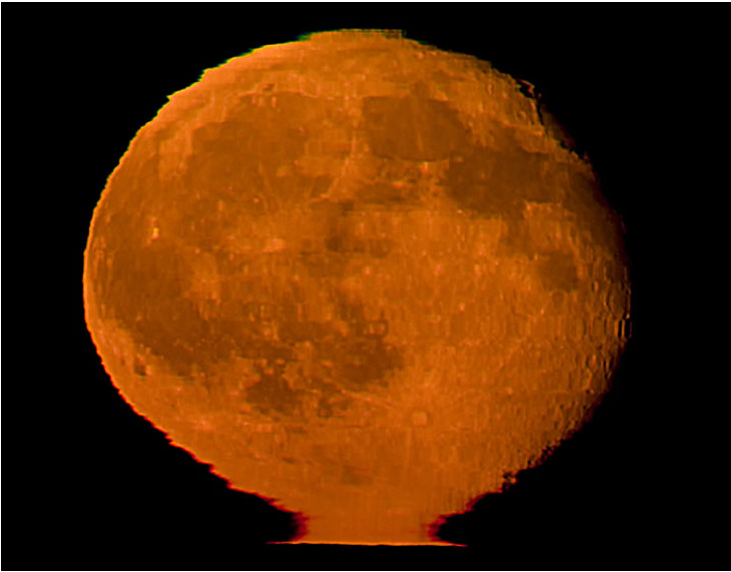Etruscan Vase over Maine
Etruscan Vase over Maine: A Spectacular Lunar Mirage
On a serene Labor Day weekend in 2009, veteran lunar mirage observer John Stetson was fortunate enough to capture a remarkable sight in Casco Bay, Maine. The moonrise he witnessed that evening, known as the Etruscan Vase or 'Omega' moonrise, displayed an extraordinary atmospheric phenomenon that is typically associated with the sun. This event left observers in awe as they witnessed the moon's image being distorted and inverted due to abnormal atmospheric refraction.
Under normal circumstances, moon and sunrise times are calculated considering the refraction caused by standard atmospheric conditions. However, when there are abnormal vertical density and temperature gradients in the atmosphere, these calculations can be significantly altered. The 'Novaya Zemlya effect' is an extreme example of this, where a cold surface layer of air can lift the sun's image above the horizon weeks before the predicted end of a long Arctic night.
In the case of the Etruscan Vase over Maine, the peculiar atmospheric refraction was caused by a warm ocean-heated air layer beneath cooler air. This phenomenon resulted in the moon's rays being curved upward towards the cooler air, creating an inverted image below the actual moon. As the moon rose higher in the sky, the lower image appeared to sink and separate from the upper image.
The refraction at the boundary between the warm and cooler air layers is highly sensitive to the angle at which the moon's rays hit it. Even slight deviations are magnified vertically, causing differences in deflection between red and green rays. This magnification produces a distinct 'red flash' between the two separating images. Additionally, when the upper limb of the moon is near the horizon, this phenomenon gives rise to the classical inferior mirage green flash.
The Etruscan Vase over Maine is a captivating example of how our atmosphere can create mesmerizing optical illusions. It serves as a reminder of the complexity and variability of atmospheric conditions, constantly offering us surprises and unique visual experiences. Here are some key points to take away from this extraordinary event:
- Abnormal atmospheric refraction can occur when there are significant variations in vertical density and temperature gradients.
- The 'Novaya Zemlya effect' is an extreme example where cold air lifts the sun's image above the horizon before the predicted end of a long Arctic night.
- The Etruscan Vase or 'Omega' moonrise is typically associated with mirages of the sun, making this lunar occurrence particularly fascinating.
- The moon's rays are curved upward towards cooler air, resulting in an inverted image below the actual moon.
- As the moon rises higher, the lower image sinks and separates from the upper image, creating a striking visual effect.
- The refraction at the warm-cool air boundary is sensitive to the angle of incidence of the moon's rays, causing vertical magnification and differences in deflection between red and green rays.
- The magnification produces a 'red flash' between the separating images and can generate the classical inferior mirage green flash when the moon's upper limb is near the horizon.
The Etruscan Vase over Maine stands as a testament to the wonders of atmospheric optics and the infinite possibilities that nature offers us. These captivating events remind us to keep our eyes open to the unexpected beauty that can unfold in the skies above us.

Etruscan Vase Moon, Labor Day Weekend
Veteran lunar mirage observer John Stetson caught this moonrise (see sequence below) at Casco Bay, Maine on Sunday evening (Sept 6, '09). �John Stetson, shown with permission.


"The light of the moon appeared on the horizon a few minutes before the predicted/appointed time. One fellow observer noticed that some of the islands that appeared on the horizon in Casco Bay under this evening's atmospheric conditions were not usually visible."
Moon and sunrise times are computed allowing for refraction by standard atmospheric conditions. Abnormal vertical density and temperature gradients can significantly alter the times. As an extreme example, the 'Novaya Zemlya effect' produced by a cold surface layer of air can lift the sun's image above the horizon weeks before the predicted end of a long Arctic night.
Abnormal atmospheric refraction produced by a warm ocean heated air layer beneath cooler air caused this Etruscan Vase or 'Omega' moonrise. These mirages more usually feature the sun.
Parallel rays from the moon are curved upward towards the cooler air. An observer above the warm air layer therefore sees an inverted image below the 'real' image of the moon or sun. As the moon rises the lower image sinks. In John's sequence it can be seen sinking and separating from the upper image.
The refraction at the warm/cooler air boundary is sensitive to the angle of incidence of the moon's rays. Small deviations are vertically magnified including the difference in deflection between red and green rays. The magnification produces the 'red flash' between the two separating images and gives the classical inferior mirage green flash when the upper limb is near the horizon.
Note: this article has been automatically converted from the old site and may not appear as intended. You can find the original article here.
Reference Atmospheric Optics
If you use any of the definitions, information, or data presented on Atmospheric Optics, please copy the link or reference below to properly credit us as the reference source. Thank you!
-
<a href="https://atoptics.co.uk/blog/etruscan-vase-over-maine/">Etruscan Vase over Maine</a>
-
"Etruscan Vase over Maine". Atmospheric Optics. Accessed on December 27, 2024. https://atoptics.co.uk/blog/etruscan-vase-over-maine/.
-
"Etruscan Vase over Maine". Atmospheric Optics, https://atoptics.co.uk/blog/etruscan-vase-over-maine/. Accessed 27 December, 2024
-
Etruscan Vase over Maine. Atmospheric Optics. Retrieved from https://atoptics.co.uk/blog/etruscan-vase-over-maine/.